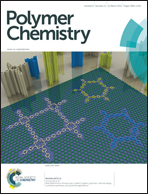Intracellular redox potential-responsive micelles based on polyethylenimine-cystamine-poly(ε-caprolactone) block copolymer for enhanced miR-34a delivery†
Abstract
An amphiphilic cationic graft polymer polyethylenimine-cystamine-poly(ε-caprolactone) (PSSP) with intracellular redox potential-responsive cleavable ability was synthesized for the first time by coupling poly(ε-caprolactone) (PCL) to polyethylenimine (PEI) via a bio-cleavable disulfide linkage. PSSP based micelles, which can degrade in the intracellular reducing environment, were developed as smart non-viral gene vectors for enhanced miR-34a delivery. The PSSP/miR-34a complexes showed effective and stable miRNA condensation with a narrow particle size of around 120 nm. The gel retardation assay showed that PSSP micelles could protect miRNA from RNase and achieve intracellular release of miRNA in the reducing environment. Compared with PEI-25k, PSSP revealed comparable transfection efficiencies in the B16F10 cell with less cytotoxicity. The B16F10 cell treated with PSSP/miR-34a complexes showed a significantly higher cell apoptosis than the PEI-25k/miR-34a complexes. These encouraging results indicated that PSSP may possess promising potential as a smart non-viral gene vector with low cytotoxicity, intracellular redox potential to trigger miRNA release and high transfection efficiency.


 Please wait while we load your content...
Please wait while we load your content...